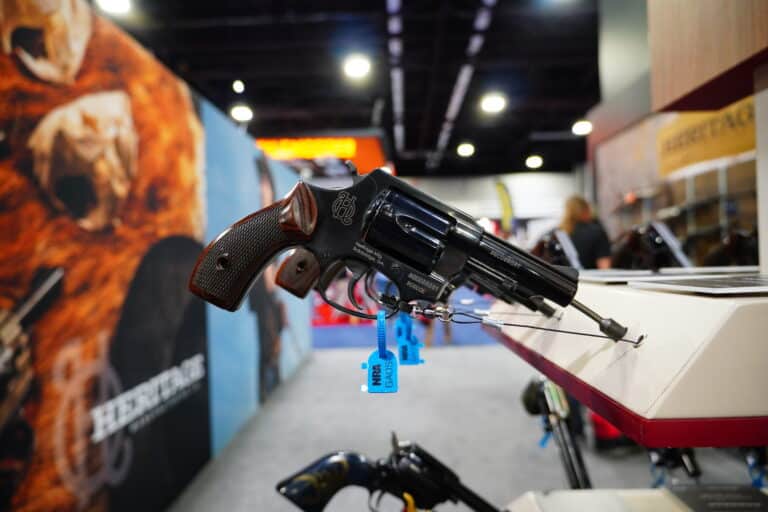The last month has clarified how the Trump Administration plans to approach the gun rights of non-violent felons. Its preferred course offers some benefits but also real downsides for gun-rights advocates.
Back in mid-March, the Department of Justice (DOJ) first unveiled its plan to revive an executive agency process for restoring Second Amendment rights to individuals who are prohibited from possessing firearms. Then, on Monday, the agency released the first results from that action, publishing the names of ten individuals in the Federal Register who now have gun rights again at the determination of Attorney General Pam Bondi.
Between those two actions, however, DOJ was also busy making it clear in legal briefs and letters to Congress that it has no desire to see the question of felon gun rights in the hands of the Supreme Court.
“Although there is some disagreement among the courts of appeals regarding whether Section 922(g)(1) is susceptible to individualized as-applied challenges, that disagreement is shallow,” Solicitor General John Sauer wrote in response to a petition for Supreme Court review last Friday in the case Hunt v. United States. “And any disagreement among the circuits may evaporate given the Department of Justice’s recent reestablishment of the administrative process under 18 U.S.C. 925(c) for granting relief from federal firearms disabilities.”
Likewise, DOJ also opted not to appeal the Third Circuit’s decision in Range v. AG, which struck down the lifetime federal gun ban for convicted felons as applied to the non-violent plaintiff.
The message sent by the moves is clear: the Trump administration is willing to work with Second Amendment supporters on their concerns about the current lifetime disarmament regime, but only to the extent that it complies with the processes outlined in current federal law. The prospect of further limiting the most commonly enforced federal gun statute with a national court ruling, on the other hand, is a bridge too far.
It’s possible that gun-rights advocates might find that to be an acceptable sweet spot. Thanks to the administration’s actions, there is now at least the early makings of the first federal gun rights restoration regime in more than thirty years, one that will be overseen by ostensibly pro-gun personnel.
Assuming the DOJ soon clarifies how the process will work for future applicants, that could mean more opportunities for some felons to regain their rights. It could also happen for far less money than the alternative of having to file costly as-applied lawsuits against the federal ban, and it won’t be subject to the interpretation of federal judges with disparate views. The practical benefits for applicants could be even larger if, as earlier reporting suggested was on the table, the DOJ implements an automated system to streamline rights restoration requests.
Of course, that reliance on reporting to evaluate its upsides is also one of the very real pitfalls of this course of action for gun-rights advocates. To this point, the DOJ has provided almost no concrete details on how applicants will be vetted and selected going forward, which predicate offenses will be prioritized and which will be disqualifying, how much bandwidth the agency has to devote to administering the restorations long-term, and more.
These open questions could become sticking points that limit the new program or even kill it altogether. The fact that one of the first ten people to have their rights restored is Mel Gibson, a celebrity with close ties to the president, doesn’t bode particularly well.
In the meantime, the existence of a new restoration process stands to undermine some of the gun-rights movement’s most promising lawsuits. Judges will likely require even the most sympathetic plaintiffs with the best arguments that the lifetime ban is unconstitutional to first attempt to secure restoration through the DOJ before pursuing a court ruling. That, in turn, risks stunting the momentum they’ve been building in enticing the Supreme Court to address who can be disarmed, and for how long, under friendlier conditions than the last time it did.
In US v. Rahimi, the Court’s most recent Second Amendment decision, a majority of the justices upheld the federal gun ban for those subject to domestic violence restraining orders. They did so, however, in a limited fashion based on the conduct of the respondent in question and the temporary nature of the ban.
“We conclude only this: An individual found by a court to pose a credible threat to the physical safety of another may be temporarily disarmed consistent with the Second Amendment,” Chief Justice John Roberts wrote in the opinion.
By contrast, plaintiffs like Range, or similarly sympathetic plaintiffs, present the exact opposite predicament. Their decades-old, non-violent convictions are not suggestive of any public safety threat. Yet, they are permanently disarmed under the terms of current federal law.
Range himself, who was barred from owning guns after lying to obtain food stamps in the 1990s, will have his gun rights restored because DOJ decided not to appeal his case. But he also won’t have a chance to argue his case at the Supreme Court because of that decision.
It’s possible DOJ may restore the rights of other plaintiffs like Range under its yet-to-be-detailed process. But by removing their claims from the judicial arena, it risks foreclosing the possibility of establishing a more lasting precedent that could impact plaintiffs across the country.
For instance, the bulk of all current Second Amendment challenges to the federal felony gun ban are brought by people who are actively being prosecuted for unlawful possession of a firearm. Assuming their conduct was otherwise non-violent, they would stand to benefit far more from a Supreme Court ruling against portions of the federal ban–even if the ruling was in an as-applied case–than from the DOJ’s post-conviction restoration process.
Lasting precedent also matters because the staying power of the DOJ’s new process, assuming it scales up in earnest, is not guaranteed.
The original iteration of the federal rights restoration process proved controversial enough that Congress opted to defund it entirely in 1992. Left in its current, uncodified state, the renewed version housed under the Attorney General could similarly be discarded by a subsequent administration.
Overall, it’s clear that the Trump team believes their new regulatory rights-restoration process will be enough to assuage Second Amendment supporters’ concerns with the current lifetime disarmament regime they’ve been fighting in court. But it’s not clear how broad that process will be. It’s also difficult to see it having as great of an impact as a Supreme Court victory on the same question, which The Court seemed positioned to hand down.






